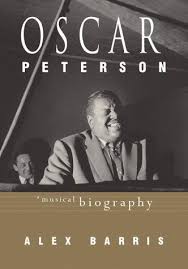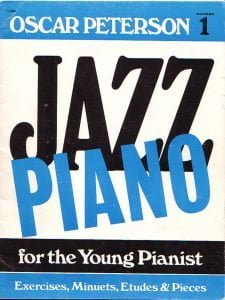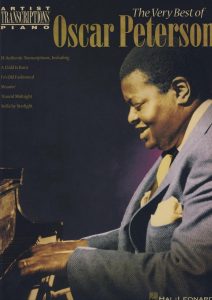Browse in the Library:
Or browse in the categories menus & download the Library Catalog PDF:
Please, remember there are many compositions and piano transcriptions of Oscar Peterson in our Library, YOUR Library.
One of the most admired, though sometimes controversial, pianists in jazz, Oscar Peterson (born 1925) in the post-war era claimed the same sort of status as earlier greats such as James P. Anderson, Art Tatum, Teddy Wilson, Fats Waller, Thelonious Monk, Bud Powell, and Bill Evans.
Possibly the most successful artist produced by Canada, he has appeared on well over 200 albums spanning six decades and has won numerous awards, including eight Grammys. During his career he has performed and recorded with, among others, Louis Armstrong, Count Basie, Ella Fitzgerald, Dizzy Gillespie, Duke Ellington, and Charlie Parker.
Peterson came of age during the bebop and swing years of the 1940s. A brute force on the piano, Peterson, similar to his idol Art Tatum, seems to play without strain and with a great command of his instrument. “Oscar told me,” said younger pianist Billy Green to Don Heckman of the Los Angeles Times, “that the first thing he does when he sits down at the piano is to gauge the key drop—how far the keys on an individual instrument need to be depressed before the hammer hits the strings.

He says— and he makes it sound so simple—that once he scopes that out, then he’s in complete control of the piano. For the rest of us, of course, there are a lot more steps involved.”
However, Peterson’s abilities proved both a blessing and a curse. His tendency to play at high speeds and overuse of harmonic complexities have led critics to call his technique too overwhelming at times. Furthermore, according to music historians, Peterson’s playing sometimes drowned out expression, leaving the intended musical statement uncommunicated. But perhaps, as many loyalists claim, Peterson just may be too good. And his durability and accomplishments have certainly validated his importance in the history of jazz.

Oscar Peterson was born on August 15, 1925, in the Canadian city of Montreal, acquiring the musical confidence he exhibits today at an early age. Born with a naturally perfect pitch, he learned to play classical piano from his older sister Daisy, who also taught piano to Montreal pianist Oliver Jones. However, Peterson credits his father with first instilling in him the importance of music. Daniel Peterson, a West-Indian born Canadian Pacific Railroad porter and amateur musician himself, insisted that each of his five children develop musical skills. In particular, he wanted them to be exposed to music outside the values of the family, unlike the hymns that Peterson’s mother (Kathleen Olivia John), a cook and a housekeeper, sang at home.
In 1930, at the age of five, Peterson began on the trumpet and piano, concentrating on the piano alone by seven years of age after a bout with tuberculosis. Although his father was a strict disciplinarian and expected perfection from his children, Peterson says that he remained always his biggest supporter. “He told me, ‘If you’re going to go out there and be a piano player, don’t just be another one be the best.’ He always had the belief in me, for which I’m grateful,” as quoted by Maclean’s contributor Nicholas Jennings. Deriving a sense of dedication from his father, Peterson thus practiced from morning until night, taking breaks only for lunch and dinner.

Later, at the age of 14, Peterson studied with Paul de Marky, a renowned Hungarian-born classical pianist. He discovered through de Markey, who, according to Peterson, could mimic Art Tatum exactly, an interest in jazz. Another teacher, Lou Hooper, led Peterson to recognize the importance of the classics, teaching his students to communicate in phrases such as “I have always felt Chopin was looking at a lovely landscape at the time he composed this piece because everything about it is so lush and green-like,” recalled Peterson, as quoted by Gene Santoro for the New York Times.
For most fans, the classic Oscar Peterson remains his trio organized in 1953, featuring bassist Ray Brown and guitarist Herb Ellis. Although drummerless, Peterson’s percussive style left little room for one anyway. The trio’s recordings together include 1955’s At Zardis, 1956’s At the Stratford Shakespearean Festival, and 1957’s At Concertgebouw. His next trio, in place by the late-1950s, included Brown and drummer Ed Thigpen, who remained with Peterson until 1965.
When Thigpen replaced Ellis, the group shifted from one in which any instrument could provide melody and harmony to the more standard piano, bass, and drums format. From here forward, Peterson would most often record in a standard trio setting. Some departures include Oscar Peterson Trio + 1, with flugelhornist Clark Terry, and the solo outing Tracks, both recorded in 1971.

Beginning in the early 1970s, Peterson embarked on a prolific touring and recording career, mostly for the Pablo Records label. Returning briefly to the drummerless trio, he recorded in 1973 Tracks and The Good Life, both featuring bassist Niels-Henning Orsted Pedersen and guitarist Joe Pass. He also recorded in a number of other settings, from duets with Dizzy Gillespie and Terry to symphony orchestra appearances. Meanwhile, Peterson was growing increasingly popular for his solo concerts, and he was recording during the 1970s and 1980s up to six albums per year.
